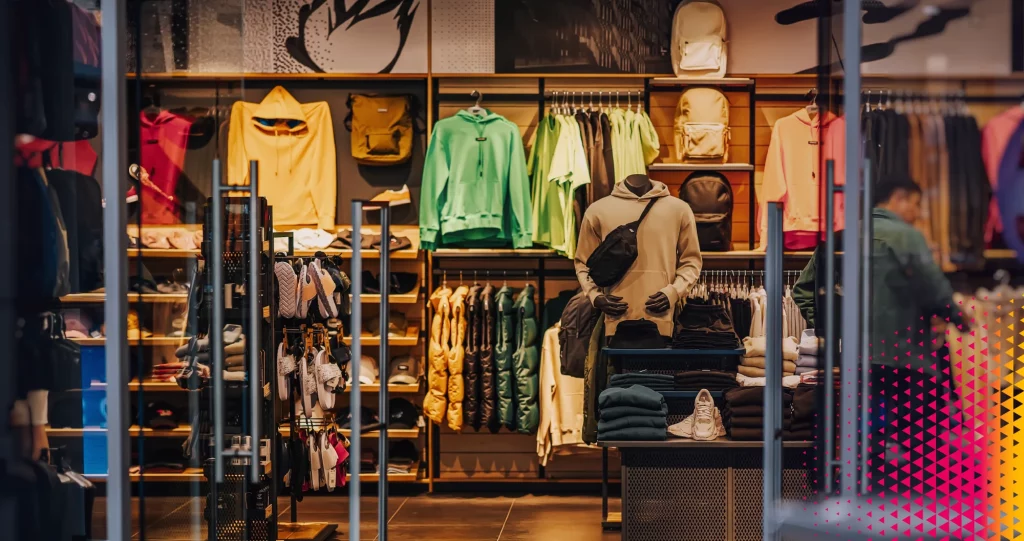4 Effective Retail Merchandising Strategies for Your Sports Store

Retail merchandising plays a vital role in enhancing store performance. Product assortment, store layout, shelf and window displays, and visual merchandising all contribute to creating an appealing and consistent shopping experience for customers, which helps drive sales and foster customer loyalty.
This is especially true in the sports retail sector, where merchandising is a key strategy even used by sports organizations themselves (club jerseys, federation accessories, etc.). In-store, showcasing products, guiding customers to the right items, and creating an atmosphere that reflects your brand’s identity help create a shopping environment that encourages purchases. Let’s take a look at the best merchandising strategies to implement in sports retail!
1. Transform the In-Store Experience
Combine Technological Innovation with Customer Experience
ASICS has prioritized optimizing its visual merchandising by redesigning its product displays and streamlining the image across its retail stores. Thanks to a new technology partner, the brand has improved consistency across its national network of stores.
The result? Product placements planned months ahead in line with marketing campaigns, standardized visual merchandising guidelines tailored to each store’s size and assortment, and clear instructions for teams to design shelves, making the setup process smoother. This approach has enabled ASICS to enhance the in-store customer experience and ensure brand consistency throughout its distribution network.
Additionally, ASICS has invested in staff training by sending sales reps to other distribution hubs for on-site training, boosting product knowledge and sales expertise. Customers are therefore assisted by knowledgeable experts who can guide them to the best products for their needs.
Adopt Experiential Marketing Techniques
In late 2016, Nike impressed the world by opening its 5,000 square-meter flagship store in New York, fully dedicated to sports experimentation. The store featured indoor basketball and soccer courts, running tracks surrounded by giant screens, and a strong focus on digital technology. Nike equipped its sales staff with mobile terminals for checkout, introduced fitting rooms with adjustable lighting, and installed interactive kiosks connected to its proprietary apps.
Beyond the digital experience, Nike created an immersive shopping environment by reinforcing its core values through merchandising. The company redesigned the entire customer journey, placing emphasis on a refreshed color scheme and language. By using keywords like “iconic” and “natural,” Nike strengthened customer identification and created an atmosphere aligned with its brand values.
The dominant use of white conveys purity and reinforces its image of quality and authenticity. This visual approach has enabled Nike to attract and retain customers while creating a consistent, immersive experience in its stores.
2. Capitalize on Product Exclusivity
Leveraging product or collection exclusivity in sports retail is a powerful strategy to attract and retain customers. A concrete example is the partnership between Decathlon and the NBA. By offering official NBA-branded basketball products under its Tarmak brand (shoes, bags, apparel, etc.), Decathlon provides unique and exclusive items in over 1,200 stores worldwide. This collaboration has positioned Decathlon as a key player in the basketball sector, drawing in enthusiasts.
Similarly, Intersport has distinguished itself by launching the first Puma Made in France collection. This exclusivity enhances the store’s image as a distributor of high-end products, offering added value to customers.
These exclusivity strategies lead to tangible results in store performance. They attract a specific, passionate customer base willing to spend more on unique products, resulting in increased revenue and higher customer loyalty. Moreover, these exclusive partnerships generate positive buzz around the store and increase in-store traffic.

3. Stay Ahead of Consumer Trends
Staying ahead of consumer expectations and current trends is crucial for successful merchandising in sports retail. A standout example of this approach is JD Sports, which focused on the athleisure trend and incorporated this fashion movement into its stores. By anticipating the growing demand for this blend of streetwear and gymwear, JD Sports adapted its product range to offer a wide variety of clothing suitable for everyday wear. This strategy allowed the company to attract a broader customer base, beyond traditional sports enthusiasts, leading to a 31% increase in sales—an impressive result!
Another example is Sport 2000, which created the WITEBLAZE brand. Aware of the rising importance of eco-responsibility in the sports industry, Sport 2000 launched a line of durable, versatile clothing made from recycled and eco-friendly materials. This initiative addresses the growing demand for environmentally-conscious products and has helped the brand differentiate itself in the market, while also building a strong connection with customers who value sustainability.
4. Offer a Seamless Customer Experience
Providing a seamless customer experience is essential for success in sports retail. This starts with optimizing the in-store journey to ensure that products are easily accessible and within reach. Clear and precise information, whether through labels or digital tools like interactive screens, is key to supporting the buying process.
An integrated loyalty program across all channels often makes a significant difference. Customers should be able to enjoy their benefits, such as accumulated points or personalized promotions, whether they shop in-store or online. This strengthens customer relationships and encourages loyalty.
Complementing the product offering with additional services also contributes to a seamless experience. For example, click-and-collect allows customers to order online and pick up their items in-store, creating a quick and convenient shopping journey. Similarly, offering home delivery or in-store repair services adds value to the product offering and enriches the overall customer experience.
A reliable management software system is crucial for supporting these initiatives. It must be able to manage the in-store customer journey, integrate loyalty programs across all channels, and handle complementary services. Invest in retail-specific software to benefit from features designed to support your business operations effectively.
Key Takeaways
- Optimize your visual merchandising and store layout to create a smooth, attractive customer journey that appeals to your audience;
- Embrace experiential marketing techniques, including the color schemes and language of your brand, to build a loyal community around your core values;
- Capitalize on exclusive partnerships or unique product offerings to attract customers to your store;
- Stay ahead of retail trends, whether in terms of style or societal and environmental concerns, to craft a product offering that resonates with today’s consumers;
- Leverage the right tools, such as specialized management software, to support your merchandising efforts and enrich the customer journey through omnichannel integration, loyalty programs, and additional services.




